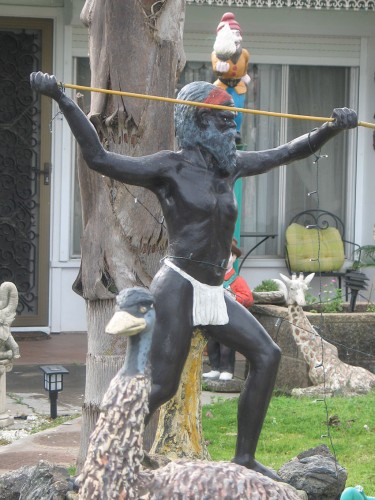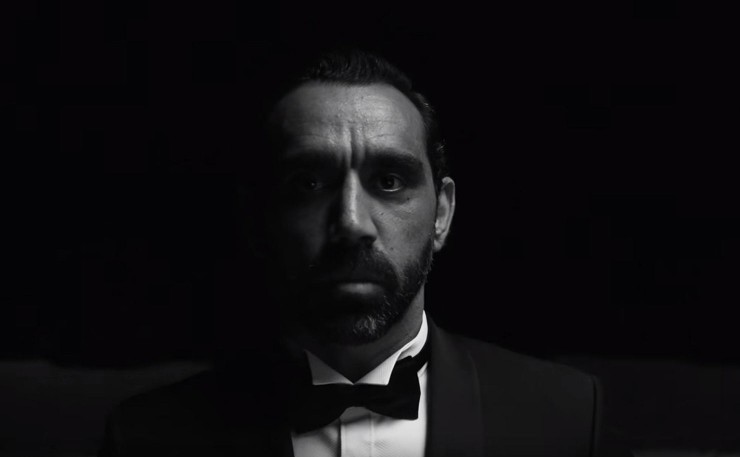Adam Goodes has been appointed the Model of Black Manhood. And Auspriders hate him for it, writes Dr Liz Conor.
Hands up who knows how the Harbour-side suburb of Manly got its name? Hint: it was not in anticipation of the recently deposed Prime Member for Manly’s hegemonic and homospooked masculinity.
No, it goes a long way further back than He Who Shall Not Be Blamed.
Manly Cove was so named by Captain Arthur Phillip, who made a number of sorties into the area to better know the ‘natives’. The Cameragal men’s ‘confidence and manly behaviour’ so impressed him, he named the spot Manly Cove.
Needless to say it already had a name: Kai’ymay or perhaps Kai’ymaygal, or Gayamaygal, but this did not signify to the British invaders. Phillip was later speared on this country, proving the old adage, He that Dispossesses the Manly should Beware their Unerring Aim.
Speaking of spear throwing, Adam Goodes has just been appointed an ambassador (actually a model, proving another adage that celebrity roles are hopelessly confused in the contemporary imagination)… ambassador for watches to that corporate sovereign, David Jones.

This has upset the Auspriders who are eBooing loudly, which means those of us hoping to defend Goodes must unqualifiedly eYay his appointment. When really, DJs is a retail conglomerate promoting reckless consumption of superfluous stuff made by underpaid people crammed in shuttered factories far off where we don’t have to think about them, involving tonnes of carbon emissions on the eve of runaway climate change.
But it surely isn’t this that has stirred the aploplexy of the beer bloated (I don’t mean to stereotype but Auspriders really have it coming).
Goodes is making a spectacle of himself. He’s a black man. They are spectacles, not self-exhibitors. We decide the terms under which they will appear before us, and the meanings of Aboriginality inferred. When we’ve finished displaying them at national jamborees and sated our curiosity, they should be bused back to their humpies, as of old.
Worse, he’s been given a license to make a spectacle of himself, and by an authoritative institution of accumulated capital, the kind that confers such licenses and thereby largely determines who we should and shouldn’t look at (read esteem).
It’s a one-sided form of regard, this Recognition business. This is the kind of recognition that has been conferred on the preposterously beautiful Aboriginal model Samantha Harris: a rupturing recognition in terms of entrenched race encounter in the popular register. For example, there have never been Aboriginal mannequins. This is telling. Very.

The conferring of this recognition – it is from white to black, mind – or the appointment of Aboriginal models is a role hitherto fulfilled (so far, at this level of recognition, only by Harris) by the impassive stalking of a half awake teen up a runway mysteriously set under her lovely feet. It is swathed in the inertia of fashion bravado.
But Goodes is Manly. Where this man treads he has prepared the ground. He thus breaks with tradition in terms of the display of Indigenous Australians as passive spectacle. Again.
You see, that thing that W.E.H. Stanner said in his 1968 Boyer Lecture about the ‘great Australian silence’ rendering Aborigines invisible was only half right. In fact, as many a cultural historian of colonialism has since argued, Aboriginal people have always been expedient spectacles – for example in this garden ornament I snapped in Queensland – when settler-heritage Australians want to evoke a sense of belonging.

Yep, I’ve got blackfellas still throwing spears on my front lawn: that makes me an Australian – with a frisson of the frontiersman literally thrown in.
Black men have held a particular fascination. Settlers have always wondered what their physical beauty told us about racial difference. So let’s take a quick survey of settler ambivalence around the appearance of Aboriginal men.
In the 1950s, white kids could pick up a paste-in-booklet from the ‘Sanitarium Children’s Library’ called Aboriginal Tribes and Customs, in which they pasted in cards retrieved from their cereal.
It was a learning exercise and they were told, ‘The aborigine possesses slender but well muscled limbs, his long straight legs being a racial characteristic. His body is usually well developed, and, although thick-set, is of an athletic build well adapted to his nomadic way of life which demands stamina and not brute strength’.
That’s right, long straight legs are racial characteristics, which rather defies racial taxonomies when you consider all the places in the world where long straight legs appear.
Going further back, to 1886, a travelogue of the Hon. Harold Finch-Hatton (poor relation of Finch-Bottom) reported that ‘the Australian Black is, of course, a very low specimen of the human race indeed’. But he adds, ‘From a physical point of view, many of the Australian blacks are exceedingly fine specimens of humanity, and possess great muscular strength’.
You see there’s a reason you’ve only seen Goodes throw that invisible spear in slow-mo. He’s beautiful. We’re intrigued. As were earlier settlers. Sunken-chested English officers were frankly stunned at the beauty of Aboriginal men.
One wrote: “The back was famously supplied with muscle, and being well curved and hollowed-out at the loin (so that a plummet-line dropped to the ground from midway between the shoulders would fall well free of the spine), gave that graceful carriage, firm and elastic tread, for which the Australian Black is remarkable.”

This squatter, Edward Curr, ruefully added: “I never see a number of our countrymen stripped at a public bath but I notice how few there are not in some measure misshapen, and how inferior in symmetry they are to the Blacks.”
Inferior, he said.
But aside from their statuesque athleticism, settlers were particularly enthralled by the carriage of Aboriginal men – women too in fact. Lieutenant-Colonel Mundy writes that “the gait of the Australian is peculiarly manly and graceful; his head thrown back; his step firm; in form and carriage he looks like creation’s lord. There is none of the slouch, the stoop, the tottering shamble, incident upon the straps, high heels and pinched toes of the patrician or the clouted soles of the clodpole white man”.
Another wrote: “The carriage of the Australian is erect and graceful, and his movement light and easy. He is never awkward, and generally free from those disproportions of the person which are so prevalent amongst civilized nations.”
Mundy noted this athletic physique continued into later years, writing of a 60 year-old man in NSW. “His proportions were remarkably fine, the development of the pectoral muscle, and the depth of chest, were greater that I had ever seen in individuals of the many naked nations through which I have travelled. A spear laid across the top of his breast as he stood up, remained there as on a shelf.”
Mundy was struck everywhere he went by “the manly and graceful bearing of the Australian”.
Another wrote: “The sight of three of four of their very smartest athletes, in the pink of their condition, running at their top speed on their higher ground, while the kangaroo was kept on the flats and floundered in the bog, was never to be forgotten. The men, attired as they were born, were models which any sculptor might have desired.”
But there was appropriate occasions for this display. Another wrote: “That dignity of deportment of which one hears not infrequently is simply the dignity of idleness. The aboriginal walks along erect through the street of the little town, or more frequently in the forest outskirt, followed at humble distance by his gin, and does evince something of that pride with which wealthy idleness in civilized life is able to encounter obligatory toil. His sinews are never tired and torn and stunted by burdens, and he can go erect. He does in his heart despise the working white man, and he shows in his countenance that fact that he has resolved to beg, steal, or eat opossum, – and at any rate to be free from toil. This so-called dignity has to me been the most odious part of his altogether low physiognomy.”
Free from toil, he said. Odious.
The missionary Taplin wrote, “Many of the middle-aged and young men have quite a dignified bearing, with an air of freedom altogether different from low-class Europeans. They are very independent in their manner; and, while they freely ask for what they want, take it, when granted, as from equals.”
As from equals, he said.
Taplin continued, “The male sex exhibit a great deal of unstudied natural grace in their deportment, their walk is perfectly erect and free, motions of body easy, and gestures natural under all circumstances, whether speaking, fighting or dancing; and with regard to agility, they throw the whiteman completely into the shade.”
A picture emerges, of homoerotic awe and resentment.
After travelling overland from Rockhampton to Cape York, Hodgkinson wrote of never having seen, “a finer specimen of the Australian aborigines than this fellow; the symmetry of his limbs was faultless, and he would have made a splendid living model for the students of the Royal academy. The haughty and dignified air of this strongly-marked and not unhandsome countenance, the boldly developed muscles, the broad shoulders, and especially the great depth of his chest, reminded me of some antique torso.”
What’s with the haughty, we might wonder.
The naturalist J. G. Wood opined, “I would refer to an Australian as the finest model of human proportions I have ever met with, in muscular development combining perfect symmetry, activity, and strength; while his head might have compared with an antique bust of a philosopher”. He also notes that while English athletes look “rather better in their ordinary dress”, European clothing has a “disadvantageous effect on the dark races” which “contrasted strangely with their former gait”.
Settlers liked to see Aboriginal men in their natural state, and wandering unimpeded as nomads. There, beyond the reach of civilization, and on still uncontested lands, they were ‘Lords of the soil’. He was ‘king of all he surveyed’ – as long as it was understood the soil was British.
Another naturalist, Barrett wrote in 1942 of the stockman: “That finely built young blackfellow with the spears looks the natural man at his best. But at times he wears a pair of dungaree slacks, an old open-necked white shirt, and a battered felt hat; then his dignity has departed. Clothes unmake the man when he is a blackfellow.”
This is why Goodes, the DJ ambassador, is being eBooed by Auspriders. His DJ suit unmakes the raw athleticism we’ve always been happy to associate with Aboriginal men, so long as they didn’t throw spears.
This ‘brand’ of Aboriginal masculine beauty is not one we’ve seen before. It is, like the caption the Aboriginal artist Brook Andrew gave to a warrior portrait, sexy and dangerous.
Donate To New Matilda
New Matilda is a small, independent media outlet. We survive through reader contributions, and never losing a lawsuit. If you got something from this article, giving something back helps us to continue speaking truth to power. Every little bit counts.




